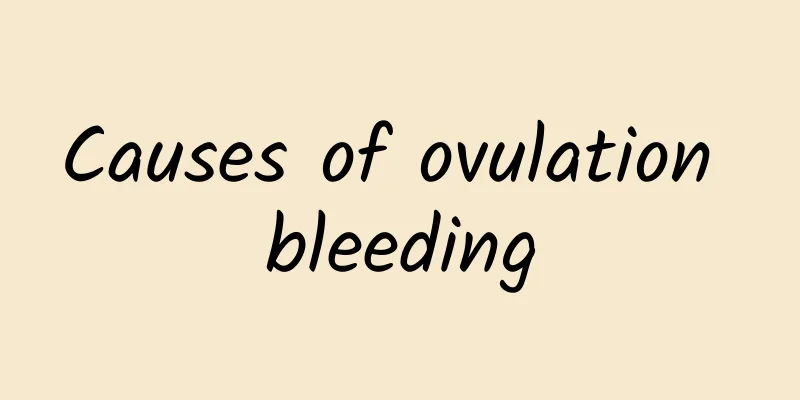Causes of ovulation bleeding

|
What is ovulation bleeding? Is it harmful to the body? What are the causes of ovulation bleeding? In fact, most people do not have the symptom of ovulation bleeding. If this phenomenon occurs, there is no need to worry too much. In fact, this is also a physiological phenomenon, but it is just because of different personal physiques. Ovulatory bleeding pathology After the mature follicle ruptures and ovulates, the estrogen level drops sharply and significantly, which cannot maintain the growth of the endometrium, causing local rupture and shedding of the endometrial surface, resulting in breakthrough bleeding. With the formation of the corpus luteum of the ovary, sufficient estrogen and progesterone are secreted to quickly repair the ruptured endometrial surface and stop the bleeding. Or it is possible that during ovulation, the mature follicles secrete more estrogen, causing endometrial congestion and leakage of red blood cells. It is also possible that when the egg is captured in the fallopian tube fimbria, the blood-containing follicular fluid is sent to the uterine cavity through retrograde peristalsis of the fallopian tube and then flows out of the cervix through the vagina. It has been reported that when examining the cervical mucus of women who ovulate during the middle of their menstrual period, it was found that about 60% of them had red blood cells under a microscope, but no bleeding was visible to the naked eye. This is not a pathological phenomenon; but women with ovulation bleeding must rule out other reproductive tract diseases, such as irregular menstruation, cervical erosion, cervical polyps, cervical cancer, endometrial polyps, submucosal uterine fibroids, endometrial adenocarcinoma, etc. Clinical manifestations of ovulatory bleeding Regular vaginal bleeding occurs during the middle of the menstrual period (ovulation period), the amount is usually not much, lasts for half a day or several days, and may be accompanied by mild abdominal pain or back pain. Diagnosis of ovulatory bleeding 1. There are typical symptoms. 2. The basal body temperature is biphasic, and bleeding occurs when the body temperature changes from low to high. 3. Endometrial biopsy shows that the endocrine response lags by at least 2 days, which can make the diagnosis. What causes ovulation bleeding? In fact, ovulation bleeding is a phenomenon that every female friend may experience. Generally, the amount of bleeding is very small and cannot be observed with the naked eye, but some people will have obvious bleeding symptoms, and the severity cannot be generalized. But in fact, the main cause of ovulation bleeding is that after the mature follicle ruptures and ovulates, the estrogen level drops sharply and cannot maintain the growth of the endometrium, causing the surface layer of the endometrium to rupture and fall off, resulting in a small amount of breakthrough bleeding. Sufficient estrogen and progesterone are secreted to quickly repair the ruptured surface of the endometrium and stop the bleeding. Or it is possible that during ovulation, the mature follicles secrete more estrogen, causing endometrial congestion and leakage of red blood cells. It is also possible that when the egg is captured in the fimbria of the fallopian tube, the blood-containing follicular fluid is sent to the uterine cavity through the retrograde peristalsis of the fallopian tube and then flows out of the cervix through the vagina. When examining the cervical mucus of women who ovulate during the mid-term period, it is found that about 60% of them contain red blood cells under a microscope, but there is no bleeding that can be seen with the naked eye. This is not a pathological phenomenon; but women with ovulation bleeding must rule out other reproductive tract diseases, such as irregular menstruation, cervical erosion, cervical polyps, cervical cancer, endometrial polyps, submucosal uterine fibroids, endometrial adenocarcinoma, etc. Of course, it is also possible that the secretion of sex hormones is disordered, causing the hormone level to fluctuate greatly during ovulation and causing obvious bleeding. Chronic inflammation of the endometrium or inflammatory thickening of the ovarian surface causes obvious congestion of the endometrium during ovulation, and the bleeding is not easy to stop on its own, or the inflammatory thickening of the follicle surface ruptures and the bleeding is larger than normal, and flows back into the uterine cavity with the peristalsis of the fallopian tube and is discharged from the body through the vagina. The duration of visible vaginal bleeding can be several hours, or 3 to 5 days, but rarely more than 7 days. In severe cases, it may continue until the next menstrual period. Some people bleed in very little amount, which stops with a few drops, or there is blood in the vagina. Generally, it rarely reaches the amount of menstruation. Bleeding may be accompanied by bloating and discomfort in the lower abdomen on one side, or dull pain or obvious pain, and even involve the waist and inner thigh. Symptoms may occur continuously every month or once every other month. Some people experience it for several months a year, and some people only experience this phenomenon once in their lifetime. |
<<: What to do if you have ovulation bleeding
>>: What are the symptoms of ovulation bleeding?
Recommend
Is the right ovarian cyst painful? What are the symptoms?
Is the right ovarian cyst painful? What are the s...
What are the symptoms of ovarian cysts caused by vulva
What are the symptoms of ovarian cysts caused by ...
Weight loss stagnated and can’t lose weight? Prepare 2 dietary therapies to defeat the fat alliance more effectively
Summer is here, but you still can’t get rid of th...
Several common tips for treating dysmenorrhea
Many female friends may not know the impact of dy...
Talk about the symptoms of atrophic vulvar leukoplakia
There are various types of vulvar leukoplakia, es...
How harmful is vulvar leukoplakia?
What are the hazards of vulvar leukoplakia? Since...
Can I take Huahong tablets after medical abortion? Not recommended
After a woman has had a medical abortion, it is n...
What are the dangers of Bartholinitis?
What are the dangers of Bartholinitis? Generally,...
The difference between uterine fibroids and ovarian tumors
Uterine fibroids and ovarian tumors are both comm...
How to check for uterine fibroids during pregnancy
How to check for uterine fibroids during pregnanc...
Can I have a natural birth with bacterial vaginosis?
I believe everyone is familiar with bacterial vag...
Beautiful wife Sui Tang shares 3 tips for beautiful skin
Sui Tang attended a gym endorsement press confere...
What fruits can you eat after abortion? 12 kinds of fruits you must eat after abortion
Abortion is a common way of miscarriage in modern...
What should you pay attention to when you have an abortion? Four principles should be followed in post-abortion treatment
As abortion becomes more and more common in life,...
What are the specific hazards of endometrial tuberculosis?
Medical investigations have found that endometria...









